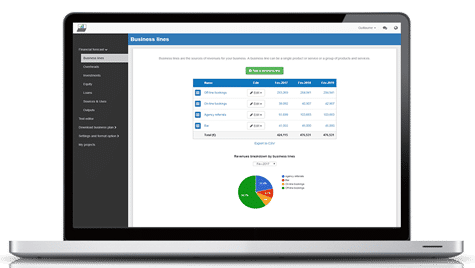How to create a financial forecast for a donut shop?
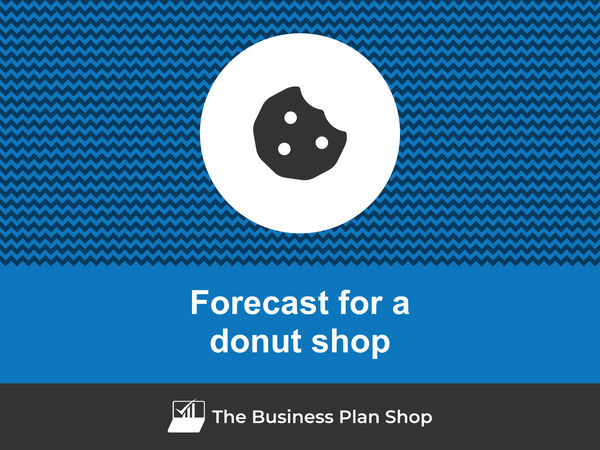
Developing and maintaining an up-to-date financial forecast for your donut shop is key in order to maintain visibility on your business’s future cash flows.
If you feel overwhelmed at the thought of putting together a donut shop financial forecast then don’t worry as this guide is here to help you.
We'll cover everything from: the main objectives of a financial forecast, the data you need to gather before starting, to the tables that compose it, and the tools that will help you create and maintain your forecast efficiently.
Let's get started!
Why create and maintain a financial forecast for a donut shop?
In order to prosper, your business needs to have visibility on what lies ahead and the right financial resources to grow. This is where having a financial forecast for your donut shop becomes handy.
Creating a donut shop financial forecast forces you to take stock of where your business stands and where you want it to go.
Once you have clarity on the destination, you will need to draw up a plan to get there and assess what it means in terms of future profitability and cash flows for your donut shop.
Having this clear plan in place will give you the confidence needed to move forward with your business’s development.
Having an up-to-date financial forecast for a donut shop is also useful if your trading environment worsens, as the forecast enables you to adjust to your new market conditions and anticipate any potential cash shortfall.
Finally, your donut shop's financial projections will also help you secure financing, as banks and investors alike will want to see accurate projections before agreeing to finance your business.
Need a solid financial forecast?
The Business Plan Shop does the maths for you. Simply enter your revenues, costs and investments. Click save and our online tool builds a three-way forecast for you instantly.
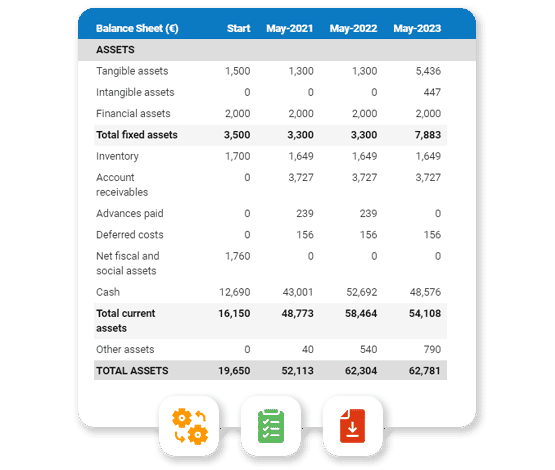
What information is used as input to build a donut shop financial forecast?
A donut shop's financial forecast is only as good as the inputs used to build it.
If you are creating (or updating) the forecast of an existing donut shop, then you mostly need your accounting information, key historical operating non-financial data, and your team’s input on what to expect for the coming years.
If you are building financial projections for a donut shop startup, you will need to have done your research and have a clear picture of your competitive environment and go-to-market strategy so that you can forecast sales accurately.
For a new venture, you will also need a precise list of the resources needed to keep the donut shop running on a day-to-day basis and a list of the equipment and expenditures required to start the business (more on that later).
Let's now take a closer look at the elements that make up your donut shop's financial forecast.
The sales forecast for a donut shop
From experience, it is usually best to start creating your donut shop financial forecast by your sales forecast.
To create an accurate sales forecast for your donut shop, you will have to rely on the data collected in your market research, or if you're running an existing donut shop, the historical data of the business, to estimate two key variables:
- The average price
- The number of monthly transactions
To get there, you will need to consider the following factors:
- Seasonal Demand: The demand for donuts can vary greatly depending on the season. During summer months, there may be a higher demand for iced donuts, while in the winter, customers may prefer hot and cozy flavors like cinnamon and pumpkin spice.
- Competitor Pricing: The prices of your competitors can greatly impact your average price. If other donut shops in the area are offering lower prices, you may need to adjust your prices accordingly to stay competitive.
- Local Events: Special events in your community, such as festivals or fairs, can greatly increase the number of transactions at your donut shop. You may see a surge in sales during these events, especially if you offer unique and delicious donut flavors.
- Health Trends: With the rise in health consciousness, some customers may be more hesitant to purchase high-calorie donuts. This may lead to a decrease in average price as you may need to offer healthier options at a lower price to attract more customers.
- Tourism: If your donut shop is located in a popular tourist destination, you may experience fluctuations in sales depending on the tourism season. During peak tourist season, you may see an increase in transactions as more people are visiting your area and looking for local treats to try.
Once you have an idea of what your future sales will look like, it will be time to work on your overhead budget. Let’s see what this entails.
Need inspiration for your business plan?
The Business Plan Shop has dozens of business plan templates that you can use to get a clear idea of what a complete business plan looks like.

The operating expenses for a donut shop
The next step is to estimate the costs you’ll have to incur to operate your donut shop.
These will vary based on where your business is located, and its overall size (level of sales, personnel, etc.).
But your donut shop's operating expenses should normally include the following items:
- Staff Costs: This includes salaries, wages, and benefits for all employees in your donut shop, including bakers, counter staff, and managers.
- Rent: You will need to pay rent for your donut shop's physical location. This can vary depending on the location and size of your shop.
- Utilities: This includes electricity, water, and gas bills for your donut shop. These costs can fluctuate based on usage.
- Ingredients: You will need to purchase ingredients such as flour, sugar, and oil to make your donuts.
- Packaging: Donuts need to be packaged in boxes or bags for customers to take away. This is an ongoing expense for your business.
- Marketing and Advertising: To attract customers to your donut shop, you will need to invest in marketing and advertising efforts such as flyers, social media ads, and promotions.
- Accountancy Fees: You may choose to hire an accountant to help with bookkeeping, taxes, and other financial aspects of your business.
- Insurance Costs: It's important to have insurance for your donut shop to protect against potential liabilities, such as accidents or damages.
- Software Licences: You may need to purchase software licences for accounting, point-of-sale, or inventory management systems.
- Banking Fees: Your business will incur fees for banking services, such as processing credit card payments or monthly account maintenance.
- Cleaning and Maintenance: Keeping your donut shop clean and well-maintained is important for customer satisfaction and health codes. This includes costs for cleaning supplies and equipment maintenance.
- Training and Development: As your business grows, you may need to invest in training and development opportunities for your employees to improve their skills and knowledge.
- Licences and Permits: You will need to obtain proper licences and permits to operate a donut shop, which may require fees.
- Legal Fees: If you encounter any legal issues, you may need to hire a lawyer to represent your business.
- Miscellaneous Expenses: There may be unexpected costs that arise in the operation of your donut shop, such as repairs or office supplies.
This list is not exhaustive by any means, and will need to be tailored to your donut shop's specific circumstances.
What investments are needed to start or grow a donut shop?
Your donut shop financial forecast will also need to include the capital expenditures (aka investments in plain English) and initial working capital items required for the creation or development of your business.
For a donut shop, these could include:
- Donut Making Equipment: This includes items such as mixers, fryers, and ovens that are essential for making and baking donuts in your shop.
- Display Cases: To showcase your delicious donuts, you will need display cases that keep them fresh and visually appealing to customers.
- Furniture and Decor: Creating a welcoming and comfortable atmosphere for your customers is important, so investing in furniture and decor, such as tables, chairs, and signage, is necessary.
- Point of Sale System: A modern and efficient point of sale system is crucial for processing transactions and keeping track of sales and inventory.
- Refrigeration Units: Proper refrigeration is necessary for storing ingredients and keeping your donuts fresh, so investing in high-quality refrigeration units is essential.
Again, this list will need to be adjusted according to the size and ambitions of your donut shop.
Need a convincing business plan?
The Business Plan Shop makes it easy to create a financial forecast to assess the potential profitability of your projects, and write a business plan that’ll wow investors.
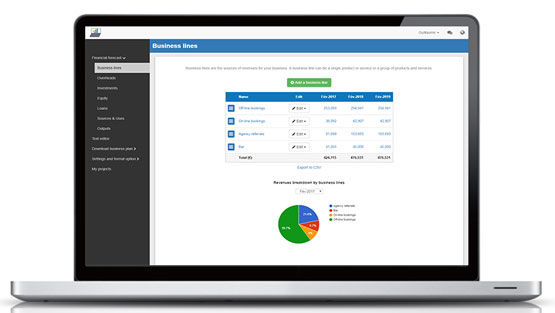
The financing plan of your donut shop
The next step in the creation of your financial forecast for your donut shop is to think about how you might finance your business.
You will have to assess how much capital will come from shareholders (equity) and how much can be secured through banks.
Bank loans will have to be modelled so that you can separate the interest expenses from the repayments of principal, and include all this data in your forecast.
Issuing share capital and obtaining a bank loan are two of the most common ways that entrepreneurs finance their businesses.
What tables compose the financial plan for a donut shop?
Now let's have a look at the main output tables of your donut shop's financial forecast.
The forecasted profit & loss statement
The profit & loss forecast gives you a clear picture of your business’ expected growth over the first three to five years, and whether it’s likely to be profitable or not.
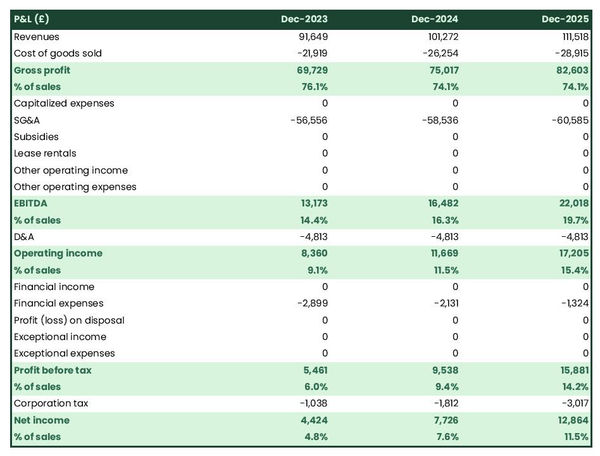
A healthy donut shop's P&L statement should show:
- Sales growing at (minimum) or above (better) inflation
- Stable (minimum) or expanding (better) profit margins
- A healthy level of net profitability
This will of course depend on the stage of your business: numbers for an established donut shop will look different than for a startup.
The projected balance sheet
Your donut shop's projected balance sheet provides a snapshot of your business’s financial position at year-end.
It is composed of three types of elements: assets, liabilities and equity:
- Assets: represent what the business possesses including cash, equipment, and accounts receivable (money owed by clients).
- Liabilities: represent funds advanced to the business by lenders and other creditors. They include accounts payable (money owed to suppliers), taxes payable and loans from banks and financial institutions.
- Equity: is the combination of what has been invested by the business owners and the cumulative profits and losses generated by the business to date (which are called retained earnings). Equity is a proxy for the value of the owner's stake in the business.
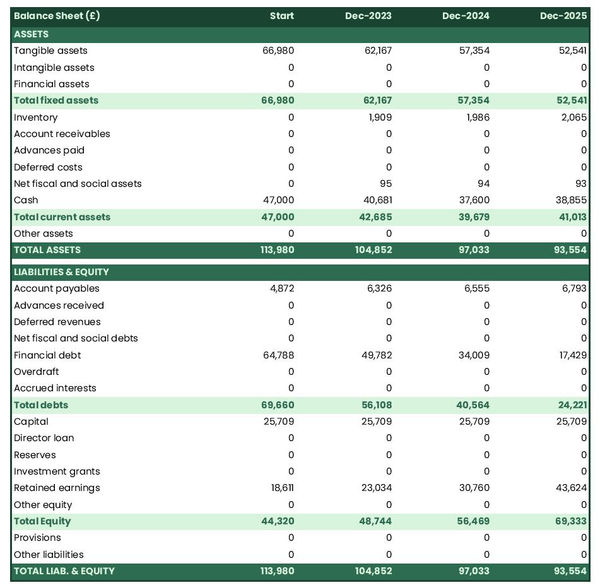
The cash flow forecast
Your donut shop's cash flow forecast shows how much cash your business is expected to consume or generate in the years to come.
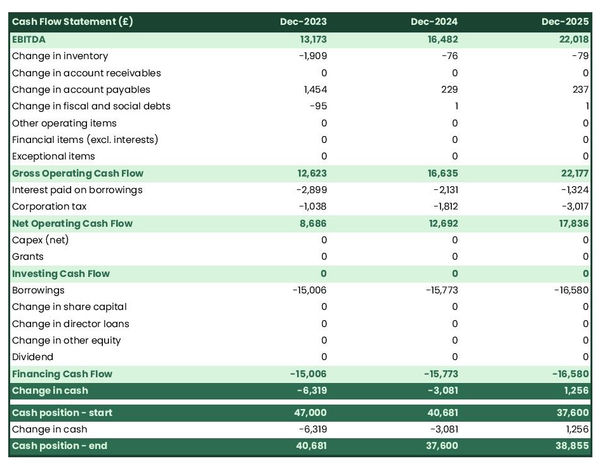
It is best practice to organise the cash flow forecast by nature to better explain where cash is used or generated by the donut shop:
- Operating cash flow: shows how much cash is generated by the operating activities
- Investing cash flow: shows how much will be invested in capital expenditure to maintain or expand the business
- Financing cash flow: shows if the business is raising new capital or repaying financiers (debt repayment, dividends)
Keeping an eye on (and regularly updating) your donut shop's cash flow forecast is key to ensuring that your business has sufficient liquidity to operate normally and to detect financing requirements as early as possible.
If you are trying to raise capital, you will normally be asked to provide a monthly cash flow forecast in your donut shop's financial plan - so that banks or investors can assess seasonal variation and ensure your business is appropriately capitalised.
Need a solid financial forecast?
The Business Plan Shop does the maths for you. Simply enter your revenues, costs and investments. Click save and our online tool builds a three-way forecast for you instantly.

Which tool should you use to create your donut shop's financial projections?
Building a donut shop financial forecast is not difficult provided that you use the right tool for the job. Let’s see what options are available below.
Using online financial projection software to build your donut shop's forecast
The modern and easiest way to build a forecast is to use professional financial projection software such as the one we offer at The Business Plan Shop.
There are several advantages to using specialised software:
- You can easily create your financial forecast by letting the software take care of the financial calculations for you without errors
- You have access to complete financial forecast templates
- You get a complete financial forecast ready to be sent to your bank or investors
- You can easily track your actual financial performance against your financial forecast, and recalibrate your forecast as the year goes by
- You can create scenarios to stress test your forecast's main assumptions
- You can easily update your forecast as time goes by to maintain visibility on future cash flows
- You have a friendly support team on standby to assist you when you are stuck
- It’s cost-efficient and much cheaper than using an accountant or consultant (see below)
If you are interested in this type of solution, you can try our forecasting software for free by signing up here.
Hiring a financial consultant or chartered accountant
Hiring a consultant or chartered accountant is also an efficient way to get a professional donut shop financial projection.
As you can imagine, this solution is much more expensive than using software. From experience, the creation of a simple financial forecast over three years (including a balance sheet, income statement, and cash flow statement) is likely to start around £700 or $1,000 excluding taxes.
The indicative estimate above, is for a small business, and a forecast done as a one-off. Using a financial consultant or accountant to track your actuals vs. forecast and to keep your financial forecast up to date on a monthly or quarterly basis will naturally cost a lot more.
If you choose this solution, make sure your service provider has first-hand experience in your industry, so that they may challenge your assumptions and offer insights (as opposed to just taking your figures at face value to create the forecast’s financial statements).
Why not use a spreadsheet such as Excel or Google Sheets to build your donut shop's financial forecast?
Creating an accurate and error-free donut shop financial forecast on Excel (or any spreadsheet) is very technical and requires both a strong grasp of accounting principles and solid skills in financial modelling.
Most entrepreneurs lack the expertise required to create an accurate financial forecast using spreadsheet software like Excel or Google Sheets. As a result, it is unlikely anyone will trust your numbers.
The second reason is that it is inefficient. Building forecasts on spreadsheets was the only option in the 1990s and early 2000s, nowadays technology has advanced and software can do it much faster and much more accurately.
This is why professional forecasters all use software. With the rise of AI, software is also becoming smarter at helping us detect mistakes in our forecasts and helping us analyse the numbers to make better decisions.
Finally, like everything with spreadsheets, tracking actuals vs. forecasts and updating your forecast as the year progresses is manual, tedious, error-prone, and time-consuming. Whereas financial forecasting software like The Business Plan Shop is built for this.
Need a convincing business plan?
The Business Plan Shop makes it easy to create a financial forecast to assess the potential profitability of your projects, and write a business plan that’ll wow investors.

Use our financial projection templates for inspiration
The Business Plan Shop has dozens of financial forecasting templates available.
Our examples contain both the financial forecast, and a written business plan which presents, in detail, the company, the team, the strategy, and the medium-term objectives.
Whether you are just starting out or already have your own donut shop, looking at our template is always a good way to get ideas on how to model financial items and what to write when creating a business plan to secure funding.
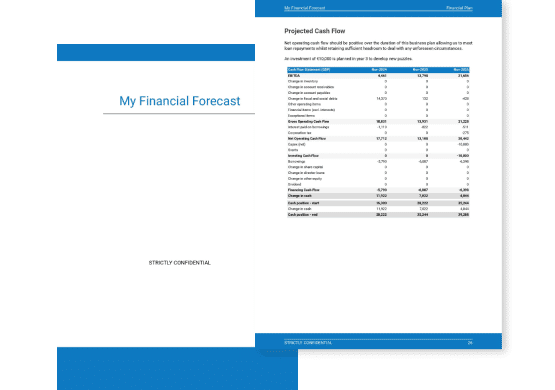
Takeaways
- A financial forecast shows expected growth, profitability, and cash generation metrics for your donut shop.
- Tracking actuals vs. forecast and having an up-to-date financial forecast is key to maintaining visibility on your future cash flows.
- Using financial forecasting software is the modern way of creating and maintaining financial projections.
We hope that this guide helped you gain a clearer perspective on the steps needed to create the financial forecast for a donut shop. Don't hesitate to contact us if you have any questions!
Need inspiration for your business plan?
The Business Plan Shop has dozens of business plan templates that you can use to get a clear idea of what a complete business plan looks like.

Also on The Business Plan Shop
Know someone who runs a donut shop? Share our business guide with them!

